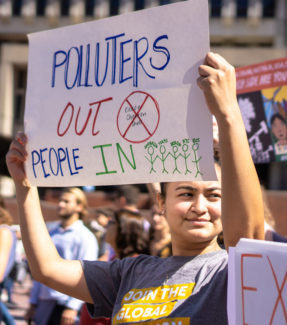Cross-posted from Alternet.
Aren’t hospitals where we go to get healthy?
Imagine this: you walk into a hospital where a loved one is being treated for lung disease, and you see the hospital selling a pack of Marlboro cigarettes. You’d likely be outraged. “Is this really happening in 2016?” you might ask. Hospitals should not be billboards for products that cause the very diseases they’re treating.
Fortunately, given tobacco’s deadly effects on people’s health, hospitals and other health institutions have systematically eliminated tobacco products from their wards. But in hospitals across the country, children continue to be treated for diet-related diseases like Type 2 diabetes on one floor while they see the world’s most recognized junk food brand—McDonald’s—on another.
It’s no accident that McDonald’s sites its stores inside hospital doors. The corporation has gone to great lengths to co-opt hospitals and other health institutions to “health-wash” its brand. The company has even offered corporate sponsorships for groups such as the Academy of Nutrition and Dietetics. In 2013, McDonald’s cozied up to the Academy as a partner for its annual meeting, which included a prominent exhibition space where the corporation promoted its sugar-laden smoothies and oatmeal.
If this sounds familiar, it’s because tactics like these come straight from Big Tobacco’s playbook. McDonald’s employs these tactics because they work: A 2006 study published in the leading medical journal Pediatrics concluded that a McDonald’s store operating inside a hospital not only affects hospital guests’ consumption during their visit, but also boosts their perception of the “healthfulness” of McDonald’s food.
The effects are even more profound on children: As the American Academy of Pediatrics points out, fast food advertising directed toward children younger than eight is “inherently deceptive.” Study after study, from the Institutes of Medicine to the National Bureau of Economic Research, have suggested that ending junk food marketing targeting children could protect the health of millions of children.
But the tide is turning. In late June, Grady Memorial Hospital, the largest hospital in the state of Georgia and the public hospital for the city of Atlanta, took the important step closing its on-site McDonald’s. In ending its decades-long relationship with McDonald’s, Grady has joined the growing movement of hospitals and health institutions that are improving their food environments. By showing McDonald’s the door, Grady is prioritizing people’s health over corporate profits.
Since 2012, eight other hospitals have severed ties with McDonald’s, including the Cleveland Clinic, Minneapolis’ Abbott Northwestern Hospital and Children’s Hospital Los Angeles. Thousands of people from Tampa to Houston are cheering on these health institutions—and calling for more to follow their lead.
In fact, thanks to hospitals’ leadership and to grassroots momentum, only 13 hospitals in the United States continue to host a McDonald’s on their premises. While 13 is a small proportion, it is still too many, especially for people in those communities, many of whom have demanded an end to such misleading and health-hazardous partnerships.
McDonald’s is the primary engine behind the breakdown of our food system and a ballooning health crisis. The corporation’s demand for a high volume of uniform ingredients promotes a range of devastating practices, from the animal cruelty associated with factory farming to labor abuses and market consolidation.
And the high levels of fat, salt and sugar have significant adverse health effects. The corporation deserves no place inside institutions of health and healing. Junk food is already going the way of tobacco in hospitals, as more and more health institutions stand up and kick McDonald’s out. We can keep the momentum going: With thousands of us standing together, we will move even more hospitals to be junk food-free.
Photo credit: enchanted_fairy/Shutterstock
This blog was originally published on August 2, 2016.




